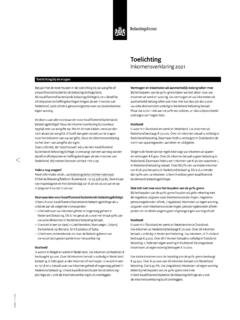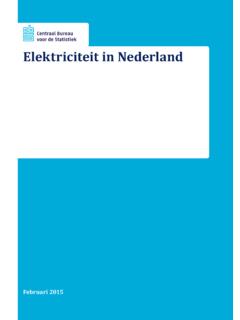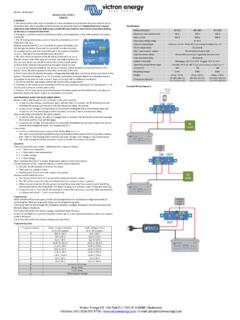Transcription of Validated methods for flue gas flow rate calculation with
1 KEMA nederland Utrechtseweg 310, 6812 AR Arnhem Box 9035, 6800 ET Arnhem The Netherlands T +31 26 3 56 91 11 F +31 26 3 89 24 77 Registered Arnhem 09080262 55106284-PGR/R&E 12-7222 Validated methods for flue gas flow rate calculation with reference to EN 12952-15 Nyk ping, Ratcliffe-on-Soar, Arnhem; January 31, 2012 Authors David Graham New Build & Technology; United Kingdom Henrik Harnevie Vattenfall Research and Development; Sweden Rob van Beek KEMA; Netherlands Frans Blank* KEMA; Netherlands (corresponding author) Under supervision of VGB European Working Group Emissions Monitoring By order of VBG Powertech Germany VGB Research Project 338; Flue gas flow KEMA nederland , Arnhem, the Netherlands. All rights reserved. It is prohibited to change any and all versions of this document in any manner whatsoever, including but not limited to dividing it into parts. In case of a conflict between the electronic version ( PDF file) and the original paper version provided by KEMA, the latter will prevail.
2 KEMA nederland and/or its associated companies disclaim liability for any direct, indirect, consequential or incidental damages that may result from the use of the information or data, or from the inability to use the information or data contained in this document. The contents of this report may only be transmitted to third parties in its entirety and provided with the copyright notice, prohibition to change, electronic versions validity notice and disclaimer. -3- 55106284-PGR/R&E 12-7222 CONTENTS page EXECUTIVE SUMMARY .. 5 NOMENCLATURE ..10 1 Introduction ..11 Rationale for the project ..12 Benefits ..13 2 The basic principles and formulas from EN 12952-15 ..14 Overview of EN 12952-15 formulas for specific flue gas volume ..15 Example of the use and interdependence of the EN 12952-15 formulas ..18 3 calculation methods for coal and analysis of variations ..20 Overview of flue gas flow calculation methods across Europe for coal firing.
3 20 Comparison with US-EPA calculation methods ..22 4 Thermodynamic calculations; output based approach ..24 Principles of the output based approach ..24 calculation of flue gas flow rate ..24 Uncertainty of the flue gas volume using the output based approach ..26 5 Calculations based on fuel heating value; input based approach ..36 Using the input based approach for oil and gas ..36 Uncertainty of the flue gas volume using the input based approach ..42 6 Validation of EN 12952-15 for coal and biomass ..44 Vattenfall validation using the ECN Phyllis database for biomass and waste ..44 KEMA dataset for coal and biomass ..52 validation on coal ..57 7 Determination by continuous measurements ..60 8 Summary ..64 9 -4- 55106284-PGR/R&E 12-7222 CONTENTS (cont) page Appendix I Extending the input based approach to biomass and waste ..70 Appendix II Overview of TC Standards ..74 -5- 55106284-PGR/R&E 12-7222 EXECUTIVE SUMMARY Operators of combustion plant need to know the flue gas flow rate to calculate the mass release of pollutant emissions.
4 For many standard fuels, the calculation of flue gas flow rate gives reliable results, with a defined uncertainty, using relatively simple procedures. The calculated dry flue gas volume is combined with emission concentrations that are reported on a dry basis. When concentrations are also measured on a dry basis, as is often the case for large combustion plant, this avoids the measurement of water vapour and hence an additional uncertainty. As shown in the schematic, the dry stoichiometric flue gas flow rate (m3/s) is obtained by multiplying the heat release (MW) by a fuel factor (m3/MJ). The heat release can be obtained directly, from the plant thermal input (fuel flow * net calorific value), or indirectly, from the power output divided by the thermal efficiency. On this basis, the fuel factor is very stable for a given type of fuel and it can be sufficient to use a fixed factor. This encompasses the methods currently used within the European power industry, based on a brief industry survey.
5 For solid fuel fired plant, hourly average flow rates are normally calculated from plant output and thermal efficiency but annual flue gas volumes are often calculated from annual fuel consumption and average fuel properties. When using a consistent set of input data, the results are comparable. Actual flowStoichiometric flow (dry)VG [m3/s]VGod [m3/s] = S x Pth T [K] K P [kPa] kPa O2, H2O0% O2, 0% H2 OFuel InputPower outputmF [kg/s]Pe [MW]H(N) [MJ/kg] [-]Net Calorific ValueThermal efficiencyFlue gas flowProcessHeat releasePth [MW] = mF x H(N) = Pe / Gas ReleaseS [m3/MJ] -6- 55106284-PGR/R&E 12-7222 Fuel factor Within this study it is shown that the European Standard EN 12952-15 is an important reference for flue gas calculation ; the standard describes the basic principles and defines empirical formulas for flue gas calculation . This is not immediately apparent or obvious from the title: Water-tube boilers and auxiliary installations - Part 15: Acceptance tests.
6 In this study, the important formulas from EN 12952-15 are presented and investigated. These yield the dry stoichiometric flue gas volume (0% O2), at and kPa, per unit of fuel consumed. In principle, the stoichiometric calculation from the elemental composition of the fuel is the most accurate and reliable approach, based on representative fuel analyses: VGod = C + H + S - O + N (m3/kg) However, in many cases the elemental composition is not known or available for the fuel mix. In this situation, the empirical formulas from EN 12952-15 for solid fuels, fuel oil and natural gas are a good alternative. These relate the flue gas volume to the net heating value of the fuel, H(N) MJ/kg. For solid fuels, such as coal and biomass, the ash and moisture mass fractions of the as received fuel must be taken into account: VGod = - (1 - Ash - H2O) + (H(N) + H2O) (m3/kg) This type of calculation is based on the heating value of the fuel and is commonly used in the Netherlands.
7 The equation is Validated on three large datasets containing coal and biomass analyses. The calculated flue gas flow is compared with the reference flue gas flow calculated from the elemental composition. It is shown that, for a wide range of coal and biomass compositions, the above formula performs very well. For light fuel oil the formula is: VGod = + H(N) (m3/kg) and for natural gas: VGod = + H(N) (m3/kg) or, using the volumetric net heating value at 0 C: VGod = + H(N) (m3/m3). -7- 55106284-PGR/R&E 12-7222 For a range of natural gas compositions, encompassing the proposed European fuel supply standard, exact calculations of the stoichiometric flue gas volume are compared with the empirical EN 12952-15 calculations. The level of agreement is again very good. Validation on fuel oil has been limited to light fuel oils fired in gas turbines and boilers.
8 For other liquid fuels, it is recommended that VGod is calculated from fuel composition. However, it is noted that the flue gas volume per unit of supplied energy, S (m3/MJ), is essentially invariant for a given fuel type and this is a better basis for calculation when compared with the flue gas volume per unit mass. The flue gas volume is derived from the combustible material in the fuel - and only the combustible material contributes to the calorific value. When the flue gas volume, per unit mass, is divided by the heating value, per unit mass, the influence of the inert fuel components is therefore largely accounted for. For a class of fuels with a given C:H ratio, the energy specific fuel factor is therefore very stable although the influence of fuel moisture in solid fuels needs to be accounted for; as the fuel moisture content increases, more fuel is required to provide the extra energy needed to evaporate the fuel moisture resulting in a higher flue gas volume.
9 Since the fuel factor, on an energy basis, is very stable, it can be appropriate to use a fixed factor for each fuel type (limited to specific commercially traded fuels). The following table gives the fixed fuel factors and an associated uncertainty at 95% confidence. This approach is similar to that required by the US EPA which uses the gross (higher) heating value. Correcting for the different heating value definition, the fuel factors reported in this study and the US EPA fuel factors agree to within for natural gas and for light oil and hard coal. Fuel Factor S m3/MJ at 0% O2 dry & Fuel type Gas Liquid Solid UR,95% For solid fuels, the fixed factor is acceptable for commercially traded hard coal and biomass with a moisture content below 25% by mass. At the reference oxygen concentration for solid fuels (6 vol%), this equates to a Fuel Factor of m3/MJ or 359 m3/GJ ( 360 m3/GJ recommended by the European Environment Agency).
10 For liquid fuel, the tabulated fixed -8- 55106284-PGR/R&E 12-7222 factor is acceptable for light fuel oils and a factor of m3/MJ is recommended here for Heavy Fuel Oil. For gaseous fuels, the fixed factor is acceptable for natural gas with a methane content higher than 80% by volume. In all cases, the uncertainty can, of course, be reduced by relating the fuel factor to calorific value or fuel composition and this is necessary for some other fuels, , natural gas with a low methane content, bio-oil or brown coal, although it may be sufficient to derive a different fixed factor that is specific to each defined fuel type. Thermal input The uncertainty of the flue gas volume also depends on the uncertainty of the thermal input. This is usually determined directly by fuel metering and CV determination - for gas and liquid fuels with a combined uncertainty below (95% confidence) for large installations that comply with the requirements of the EU Emissions Trading Scheme.









